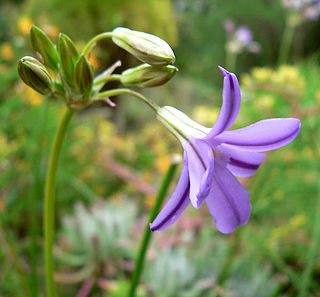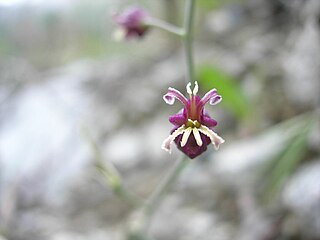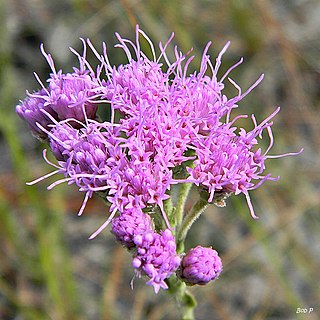
Caulanthus inflatus, the desert candle, also referred to as squaw cabbage, is a flowering plant in the family Brassicaceae, native to the Mojave Desert of California and Nevada, and the southern Sierra Nevada and Transverse Ranges in the United States. It is found at elevations between 150–1,500 metres (490–4,920 ft).

Cardamine bulbosa, commonly called bulbous bittercress or spring cress, is a perennial plant in the mustard family. It is native to a widespread area of eastern North America, in both Canada and the United States. Its natural habitat is moist soils of bottomland forests and swamps, often in calcareous areas.

Streptanthus is a genus of plants within the family Brassicaceae. There are 58 known species within the genus Streptanthus, distributed through the western and south-central United States and northern Mexico. The common names for this genus are twistflower and jewelflower. Twenty-four of the species and eleven lesser taxa occur in California, thirty-two of which are California endemics; seventeen of these California taxa are classified as rare plants.

Heteranthera limosa is an annual flowering plant in the water hyacinth family known by the common names ducksalad and blue mudplantain. It grows in shallow water or on mud. It is considered a threatened species in parts of the central United States, and an invasive species weed in California, where it is a nuisance in rice paddies. It is also occasional in Florida waterways.

Caulanthus is a genus of plants in the family Brassicaceae. Plants of this genus may be known as jewelflowers. They are also often referred to as wild cabbage, although this common name usually refers to wild variants of Brassica oleraceae, the cabbage plant. Jewelflowers are native to the southwestern United States and northern Mexico, where they are often found in warm, arid regions. Many species have an enlarged, erect stem rising from a basal rosette of leaves. Flowers arise directly from the surface of the stem; many species have colorful, bell-shaped flowers. The best-known of the fourteen species is probably the desert candle.

Brodiaea kinkiensis is a species of Brodiaea also with the common name San Clemente Island brodiaea. This flower is endemic to San Clemente Island, one of the Channel Islands of California.

Butomus is the only known genus in the plant family Butomaceae, native to Europe and Asia. It is considered invasive in some parts of the United States.

Streptanthus lasiophyllus, many synonyms including Guillenia lasiophylla, is a species of mustard plant known by the common names California mustard and slenderpod jewelflower. It is native to western North America from British Columbia to northern Mexico. It can be found in a variety of habitats such as desert flats, gravelly areas, limestone rocks, talus slopes, sandy banks, and grassy fields. This is a thin-stemmed erect annual herb with long lobed, toothed leaves surrounding the base of the plant and smaller leaves lining the stem. The top of the plant is occupied by an inflorescence of flowers, each with widely spaced oval-shaped white or yellowish petals half a centimeter long. The fruit is a flat, narrow silique up to 7 centimeters long which hangs downward from the stem. Flowers bloom March to June.

Caulanthus amplexicaulis is a species of flowering plant in the family Brassicaceae known by the common name claspingleaf wild cabbage.

Caulanthus cooperi is a species of flowering plant in the family Brassicaceae known by the common name Cooper's wild cabbage. It is native to the southwestern United States and Baja California, where it is a common plant in a number of open, sandy habitats. This annual herb produces a slender, somewhat twisted stem with widely lance-shaped to oblong leaves clasping it. The flower has a rounded or urn-shaped coat of pinkish or pale greenish sepals enclosing light yellow or pale purple petals. The fruit is a straight or curving silique several centimeters long.

Mitella ovalis is a species of flowering plant in the saxifrage family known by the common names coastal miterwort and oval-leaf miterwort. It is native to western North America from southwestern British Columbia, including Vancouver Island, to northern California as far south as Marin County. It grows in moist, shady habitat, such as coastal forests and streambanks.

Sagittaria lancifolia, the bulltongue arrowhead, is a New World perennial, monocot plant in the family Alismataceae, genus Sagittaria, with herbaceous growth patterns.

Helianthus decapetalus, known by the common names thinleaf sunflower and thin-leaved sunflower, is a perennial forb in the family Asteraceae. It is native to the Eastern and Central United States and Canada, from New Brunswick west to Iowa, Wisconsin, and Ontario, south as far as Georgia and Louisiana. It produces yellow composite flowers in late summer or early fall.
Vaccinium boreale, common name northern blueberry, sweet hurts, or bleuet boréal, is a plant species native to the northeastern United States and eastern Canada. It has been found in Québec, New Brunswick, Nova Scotia, Newfoundland and Labrador, Maine, New Hampshire, Vermont, and New York State. It grows in tundra, rocky uplands, and in open conifer forests at elevations up to 2,000 metres (6,600 ft).

Aletris farinosa, called the unicorn root, true unicorn, crow-corn, white colic-root or white stargrass, is a plant species found across much of the eastern United States. It has also been reported from the southern part of Ontario, Canada. It is known from every state east of the Mississippi River except Vermont, as well as Texas, Oklahoma, Arkansas and Louisiana. Its native habitats include moist peaty, sandy or gravelly areas.

Sagittaria graminea, the grassy arrowhead or grass-leaved arrowhead, is an aquatic plant species native to eastern North America.

Bradburia pilosa, the soft goldenaster, is a North American species of flowering plants in the family Asteraceae, native to the south-central United States, primarily the southeastern Great Plains and lower Mississippi Valley, in the states of Texas, Oklahoma, Kansas, Missouri, Arkansas, Louisiana, Tennessee, Mississippi, and Alabama. Additional populations are reported farther east but these appear to be introductions. Its habitats include disturbed roadsides and pine-oak-juniper woods.

Carphephorus corymbosus, the Florida paintbrush or coastal plain chaffhead, is a species of North American plants in the family Asteraceae. They are native to the southeastern United States in the States of Florida, Georgia, and South Carolina.

A superbloom is a rare desert botanical phenomenon in California and Arizona in which an unusually high proportion of wildflowers whose seeds have lain dormant in desert soil germinate and blossom at roughly the same time. The phenomenon is associated with an unusually wet rainy season. The term may have developed as a label in the 1990s.

Lindheimera texana, commonly known as Texas yellow star, is a species of flowering plant in the tribe Heliantheae within the family Asteraceae. It is found in the south-western United States and northern Mexico (Coahuila). Other common names include star daisy, Texas star and Lindheimer daisy,



















